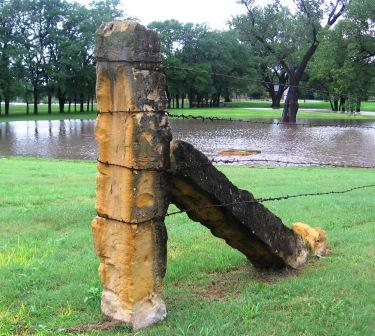The Early Years: A Brief History of Barbed Wire
| Development of Barbed Wire
| Kansas Fence Laws
|
| Railroads and Barbed Wire
| Recommended Readings
|
 The Development of Barbed Wire
The Development of Barbed Wire
 Prior to 1863, several individuals created forms of fencing that could
be considered as barbed wire. None of these creations ever reached the
mass market. In 1863 by Michael Kelly developed a type of fence with points affixed to twisted strands of wire.
Had his invention been properly promoted, he could have gained distinction
as the Father of Barbed Wire. It wasn't until ten years later that another
inventor filed a patent that would spark the development of the barbed wire industry.
Prior to 1863, several individuals created forms of fencing that could
be considered as barbed wire. None of these creations ever reached the
mass market. In 1863 by Michael Kelly developed a type of fence with points affixed to twisted strands of wire.
Had his invention been properly promoted, he could have gained distinction
as the Father of Barbed Wire. It wasn't until ten years later that another
inventor filed a patent that would spark the development of the barbed wire industry.
At the county fair in DeKalb, Illinois in 1873, Henry M. Rose had on exhibit a new idea in fencing. It was a wooden rail with a series of sharp spikes protruding from the sides of the rail. The fence rail, patented earlier that year on May 13, was designed to be attached to an existing fence to "prick" an animal when it came into contact with the rail and keep livestock from breaking through.
This fence attracted the attention of each of the three men, Joseph Glidden, Jacob Haish, and Isaac Ellwood. Each man had the idea to improve upon Rose's fence by attaching the spikes (barbs) directly to a piece of wire. Each went their separate ways to work on an invention that would soon bring them together.
Legend states that Glidden's wife Lucinda encouraged him with his idea to enclose her garden. Glidden experimented by bending a short wire around a long strand of straight wire, by modifying a coffee mill. Two pins on one side of the mill, one centered and the other just enough off center to allow a wire to fit in between. When the crank was turned, the pins twisted the wire to form a loop. The wire was then clipped off approximately one inch on each end at an angle to form a sharp point. Barbs were placed on one of two parallel strands of wire. The two strands of wire were attached to a hook on the side of an old grinding wheel. As the barbs were positioned, the wheel was turned twisting the two strands of wire and locking the barbs in place.
During this time, Isaac Ellwood, a hardware merchant, had been unsuccessful in perfecting his own version of barbed wire. When Joseph Glidden was awarded a patent on November 24, 1874 for his creation known as "The Winner," he and Ellwood formed a partnership to establish The Barb Fence Company.
Jacob Haish also had patented his own wire by this time but had not made a serious attempt to promote and sell it. Haish, wanting the credit for barbed wire himself, didn't like the idea of Glidden and Ellwood forming a partnership and strived to bring them down. When Haish learned that Glidden had applied for a patent in late 1873, but was denied, Haish filed a patent for his creation, the “S-Barb” in July of 1874. A few days later he filed interference papers against Glidden and an intense legal dispute ensued. Even though Haish was awarded a patent first, Glidden won the dispute because he had filed his patent before Haish. Unwilling to admit defeat, Haish claimed the title of “The inventor of barbed wire.” Nevertheless, it was Joseph Glidden who became known as the “Father of Barbed Wire.”
 The enactment of the Homestead Law in 1862 drew thousands of settlers to the new state of Kansas.
As settlers began fencing their lands to protect crops from the free-roaming cattle and Bison there became a need to
define responsibility should livestock damage crops. In addition, with miles of fences being constructed daily,
there arose a need to define a lawful fence. In Kansas, lawmakers debated the issue and wrote legally binding definitions
of proper fencing. When cropland adjoined land used for grazing, the statute of Kansas at first placed the burden
on the landowner to fence out cattle lawfully at large. This determination was based on free range grazing laws
which permitted cattle to graze unrestrained. Although the farmer was responsible for constructing the fence,
he was afforded many advantages provided the fence met established criteria.
However, in later years, the responsibility shifted and ranchers became responsible for fencing their livestock.
A requirement to “fence-‘em out” became a requirement to “fence-‘em in.” [Continued]
The enactment of the Homestead Law in 1862 drew thousands of settlers to the new state of Kansas.
As settlers began fencing their lands to protect crops from the free-roaming cattle and Bison there became a need to
define responsibility should livestock damage crops. In addition, with miles of fences being constructed daily,
there arose a need to define a lawful fence. In Kansas, lawmakers debated the issue and wrote legally binding definitions
of proper fencing. When cropland adjoined land used for grazing, the statute of Kansas at first placed the burden
on the landowner to fence out cattle lawfully at large. This determination was based on free range grazing laws
which permitted cattle to graze unrestrained. Although the farmer was responsible for constructing the fence,
he was afforded many advantages provided the fence met established criteria.
However, in later years, the responsibility shifted and ranchers became responsible for fencing their livestock.
A requirement to “fence-‘em out” became a requirement to “fence-‘em in.” [Continued]
 Railroads and Barbed Wire
Railroads and Barbed Wire
 Railroads were required to construct a legally defined fence along the
right-of-way wherever tracks crossed lawfully fenced private land. Railroads
did not receive the same benefits granted to landowners, however. They
were exempted from rights of recourse (as given to landowners) when livestock
trespassed upon their right-of-way.
Railroads were required to construct a legally defined fence along the
right-of-way wherever tracks crossed lawfully fenced private land. Railroads
did not receive the same benefits granted to landowners, however. They
were exempted from rights of recourse (as given to landowners) when livestock
trespassed upon their right-of-way.
Another problem was that neighboring farmers and ranchers started to "borrow" wire from railroad fences for their own use. With the enormous number of barbed wire fences being legitimately sold, it was almost impossible to find the thief and recover the stolen wire. To combat the problem, unique variations of "The Winner" were created exclusively for railroad use. The design consisted of one or more square strands of wire woven among one or more traditional round lines. For many years, railroad companies were principal customers of The Barb Fence Company. Once again barbed wire had struck a victory in the quest to settle the untamed West. [More]
 Recommended Readings
Recommended Readings
The Wire That Fenced the West, by Henry D. and Frances McCallum, University of Oklahoma Press, 1985 (out of print).
The Bobbed Wire Bible IX, by Jack Glover, Cow Puddle Press, 1996 (out of print).
Barbed Wire Identification Encyclopedia - Fifth Ed.,by Harold Hagemeier, DRM Publishing Co., 2002
Barriers - An Encyclopedia of United States Barbed Fence Patents, by Campbell and Allison, 1986